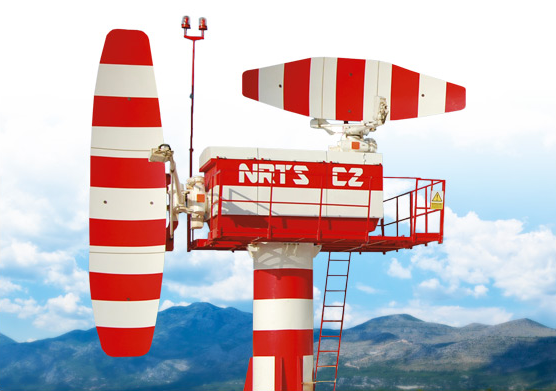
A next-generation approach radar
PAR RP-5NG is a Precision Approach Radar for directing the approach of all types of aircrafts and for recording all phases of the approach process. All technical parameters are in compliance with international ICAO Annex 10 standards.
The radar allows for automatic target tracking from the fourth turnover until the touch point. Deviations of the aircraft from the theoretical approach trajectory are shown on a monitor in both vertical and horizontal terms, following the target. If the deviation exceeds allowed limits, the radar warns the approach dispatcher. The entire process is recorded on a memory device and allows for subsequent review of the whole approach process from the record.
Approach radar is composed of three main parts:
- A propelling mechanism is installed on a solid pole with vertical and horizontal antennas. Apart from a basic swaying motion in specific sectors, the antennas can turn to both approach directions in all weather conditions.
- Containers with radar system electronics. These contain two Solid State semiconductor transmitters, a device for radar processing and noise suppression, a controlling and monitoring radar system, a device for radar data transmission to the directing dispatcher’s post, a radar movement control system, airing unit, and an Uninterruptible Power Supply (UPS).
- Operator (dispatcher) workspace – ARM
Antenna unit is situated conveniently close to the runway.
The electronics container is placed next to the antenna unit. Radar operation is fully automated. Presence of trained personnel is only necessary for prescribed checks and maintenance.
Electronic devices within the container is composed of two rack cabinets and two semiconductor transceivers placed on the side of the container. The operational frequency band of the transmitter is between 9,10 GHz and 9,50 GHz. The device for complex processing of radar information is placed within one cabinet, the device for controlling the antenna system propeller, the propeller control systems, the waveguide airing unit and an intelligent uninterruptible power supply is placed in the second cabinet. The container is equipped with an independent air conditioning.
Main parameters of the landing radar
| Instrument distance (currently depends on aircraft type and weather conditions) | 40 km |
| Minimum distance | 300 m |
| Functional sector of the side antenna | ±15° nebo +10° 20° (30°) |
| Functional sector of the altitude antenna | -1° do +9° |
| Maximum deviation of measured values from target’s position: | |
| 1) Horizontally | ≤ 6´ |
| 2) Vertically | ≤ 6´ |
| 3) Distance | ≤ 120 m |
| Radar information updates up to a max | 0,6 s |
| Transmitter is of a semi-conductor type (Solid State), output impulse power is | 350 W |
| Emitted signal form up to 5 km, monochromatic signal s with a signal timescale of 0,3 μs Beyond 5 km composite signal with non-linear frequency modulation in the form of two sequential signals with mutually different frequency, each with a length of 30 μs | |
| Receiver type – triple channel, super-heterogeneous coherent | |
| Receiver noise coefficient | ≤ 4,0 dB (including all receiver route parts) |
| Sensitivity | not worse than -110 dBm (considering LFM signal compression) |
| Bandwidth | ≥ 5 MHz |
| Dynamic range | ≥ 140 dB |
| Local terminal | LCD display |
Operator (dispatcher) workstation (ARM)
Approach dispatcher’s ARM shows full information about the landing process. The dispatcher can select to display information from the surveillance radar, weather station information, the aircraft’s fight plan information, direction preview information, reference or cartographic information. ARM can be placed in the air traffic control tower. Zone administrator’s, traffic control director’s or assistant’s tasks can be performed if required. A reference tablet is additionally installed along with a standard remote control and a device for switching and directing radio communication, loud communication and emergency communication. All information about the air traffic control’s actions is stored:
- Information about directing, in real time
- Topographic data – coordinates and vector measurement of point motion in airspace
- Route and data for direction detection
Specification:
- Lifespan 15 let (max. 100.000 hours)
- Power Supply 3×230/400 V (+10% ‒15%) 50 Hz ± 2%
- Required input ≤ 4,8 kW
- In case of power shortage, the radar is powered by the UPS for 15 minutes
- No. of simultaneously tracked targets up to 124
- Information storage period ≥ 30 days
- Interface language is English, Russian or other (on demand)
Environment conditions:
- Internal operational conditions from +5ºС to +30ºС
- External operational conditions from ‒25ºС to +70ºС
- Wind velocity up to 30 m/s during operation up to 45 m/s in static mode





